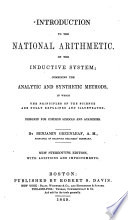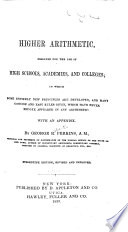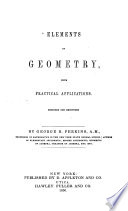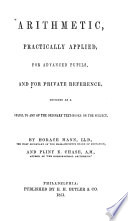 | Benjamin Greenleaf - Arithmetic - 1849 - 336 pages
...hypothenuse, and the angle at ' B is a right angle. Base. ART. 373. In every right angled triangle the square of the hypothenuse is equal to the sum of the squares of the base and perpendicular, as shown by the following diagram. It will be seen by examining... | |
 | Nathan Daboll, David Austin Daboll - Arithmetic - 1849 - 260 pages
...perpendicular 48 rods, how many acres ? Ans. 7a. 2r. 36 roife. ART. 2. — In .every right-angled triangle, the square of the hypothenuse is equal to the sum of the squares of the other two sides. 1. Hence, when the legs are given, to find the ttypothenuse. RULE.... | |
 | George Campbell - English language - 1849 - 472 pages
...instance, of the first kind, the following affirmations : " The cube of two is the half of sixteen." " The square of the hypothenuse is equal to the sum of the squares of the sides." " If equal things be taken from equal things, the remainders will be equal."... | |
 | George Roberts Perkins - Arithmetic - 1850 - 356 pages
...side opposite the right angle is called the hypothenuse. It is an established proposition of geometry, that the square of the hypothenuse is equal to the sum of the squares of the other two sides. From the above proposition, it follows that the square of the hypothenuse,... | |
 | Roswell Chamberlain Smith - Arithmetic - 1850 - 314 pages
...triangles the longest side is usually considered the Base. 15. In every right-angled triangle, — The square of the hypothenuse is equal to the sum of the squares of the other two sides ; as, 5033 402+302. [Fig. 8.] 16. Hence, to find the different sides,... | |
 | George Roberts Perkins - Geometry - 1850 - 332 pages
...shall have (9+3)x(9-3)=12x6=9 " -3'=81-9=72. PROPOSITION VIII. THEOREM. In any right-angled triangle, the square of the hypothenuse is equal to the sum of the squares of the other two sides. Let ABC be a right-angled triangle, having the rightangle C ; then... | |
 | Jeremiah Day - Geometry - 1851 - 418 pages
...manner of stating them from the figure, as to be able to explain them, whenever they are referred to. 94. Other relations of the sine, tangent, &c., may...square of the hypothenuse is equal to the sum of the squares of the perpendicular sides. (Euc. 47. 1.) In the right angled triangles CBG, CAD, and CHP,... | |
 | Edward Deering Mansfield - Education - 1851 - 348 pages
...it was Pythagoras, in the year five hundred and ninety before Christ, who discovered the fundamental proposition that the square of the hypothenuse is equal to the sum of the squares of the other two sides. Euclid appeared in the year three hundred BC His object was to systematize... | |
 | Horace Mann - 1851 - 384 pages
...measured lines 10ft. apart. This mode of operation is founded on the property of right-angled triangles, that the square of the hypothenuse is equal to the sum of the squares of the other two sides. A roof is said to have a true pitch, when the length of each rafter... | |
 | William Smyth - Algebra - 1851 - 272 pages
...of the other two sides ? NOTE. In solving this and other similar questions, it will be recollected that the square of the hypothenuse is equal to the sum of the squares of the other two sides, and the area is equal to one half the product of these sideS. ANS.... | |
| |